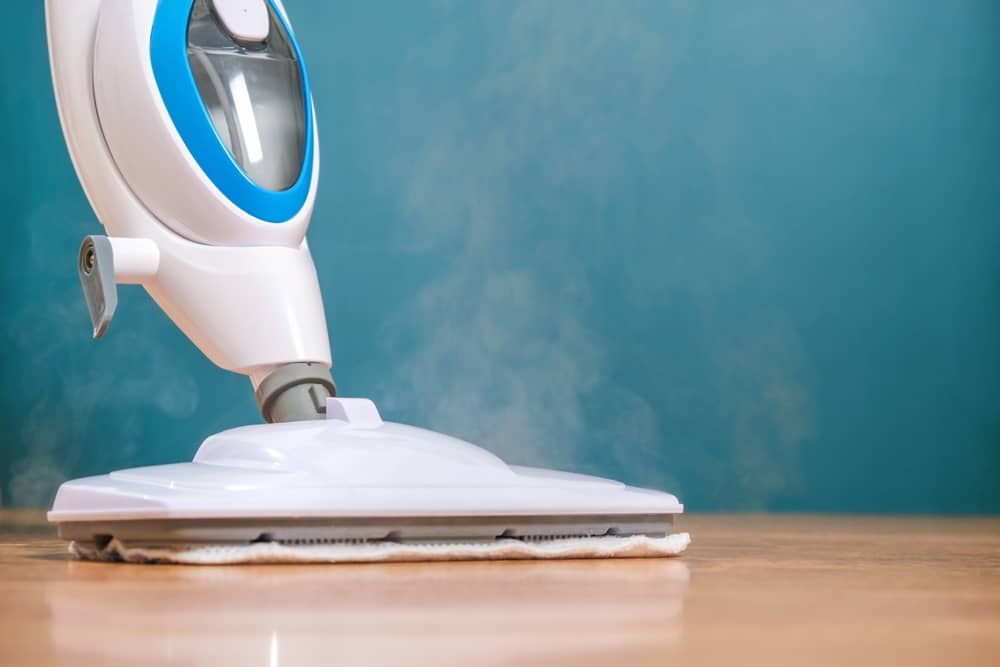A shiny, clean floor can elevate the appearance of your entire home. But who has time to scrub dozens of tiles or mop all that hardwood?
Thankfully, there’s an easier and more efficient way to clean – a steam mop.
Steam mops use plain hot water to clean and remove dirt, grime, and stains from your floors. No need for chemical cleaners and no need for much elbow grease.
Knowing how to use a steam mop properly will help you get the most out of it. So prep the water and mop pads – it’s full steam ahead!
Benefits of Steam Mopping | How Often to Steam Mop | Safe Flooring Materials | Unsafe Flooring Materials | How to Use a Steam Mop | Using a Steam Mop on Carpet | Tips and Maintenance | Steam Mop vs. Regular Mop
How Does a Steam Mop Work?
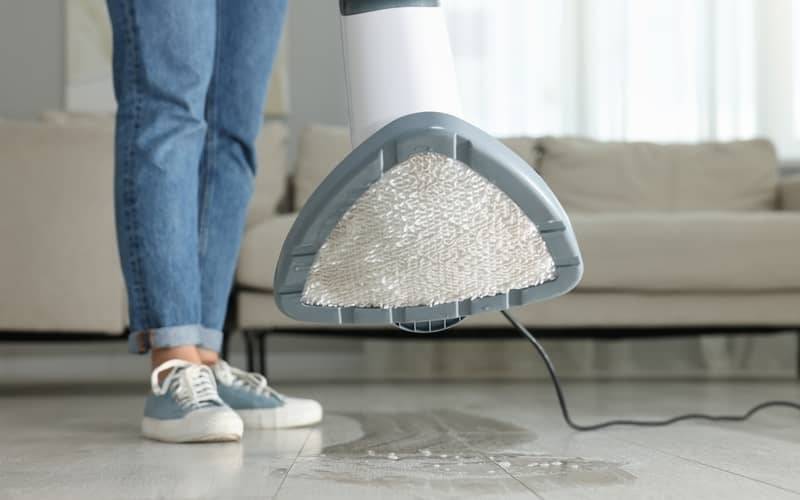
Steam mops work by heating liquid in a reservoir until it turns to steam – about 90-120ºC (200-250ºF).
The appliance then releases the high-temperature steam through the mop head. It penetrates the floor’s surface, loosening dirt, grime, and stains.
The mop pad attached to the head will pick up the dirty water, just like a regular mop!
Plus, the high temperatures help sanitise your household floors – although don’t expect steam mops to kill bacteria and germs completely.
There are also different types/models, which you should consider when choosing the best steam mop for your home.
- Standard: The most basic steam mop for cleaning hard floors
- Handheld: Smaller and more lightweight for cleaning tight or hard-to-reach areas
- Steam cleaners: More versatile tools that can clean other surfaces, such as carpets or upholstery
Note that steam mops are different from wet/dry vacuums!
Steam mops produce steam and absorb the dirty water with mop pads, but they cannot suction liquid like a wet/dry vacuum does.
Benefits of Using a Steam Mop
The biggest benefit of using a steam mop is convenience – it saves you time and resources when cleaning hard floors.
Other benefits of a steam mop include:
- Easier cleaning for stains and grime
- Attachments for different surfaces
- Less water used versus traditional mops
- No additional cleaners or harsh chemicals
- High heat can kill some bacteria and germs
Plus, you don’t need to carry around heavy buckets of water, which could cause slips and trips.
You’re also not reusing water like you would with regular mops. That makes steam mops more sanitary!
How Often Should You Use a Steam Mop?
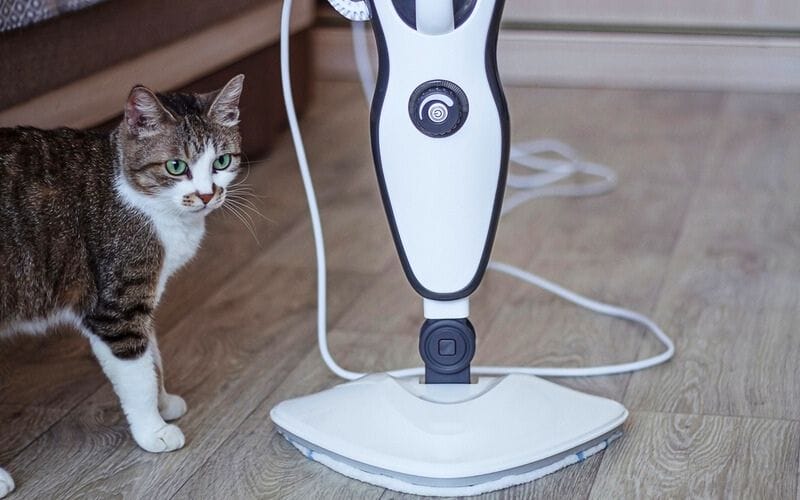
You’ll get the best results from routine cleaning, so use a steam mop to clean floors once a week.
You can pair steam cleaning with a deep clean of the floors once a month.
If you have a big family, pets, or an allergy-prone household, you may need to steam clean more frequently.
What Floors Can You Use a Steam Mop On?
As a general rule, you should only use steam mops to clean sealed hard floors.
Excess moisture from the steam can damage unsealed surfaces, causing warping, swelling, or mould.
Always check your flooring manufacturer’s instructions to know whether it’s safe to clean floors with a steam mop.
Ceramic and porcelain tile floors
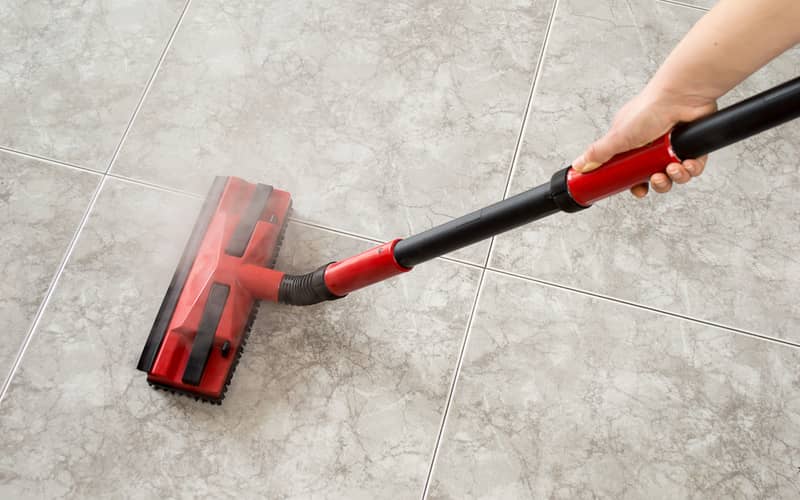
Steam mops are great for cleaning sealed ceramic tile and porcelain tile! Both materials can handle the heat – so no, steam mops generally don’t damage tile floors.
Steam is also good for cleaning grout lines that gather and absorb day-to-day household dirt. Check if your steam cleaner comes with a grout attachment or brush.
When cleaning tile floors with a steam mop, make sure to dry the floor completely afterwards. Re-seal your grout every 6 months to keep out dirt and moisture.
Linoleum floors
Steam cleaning is generally safe for sealed linoleum floors, as long as the sheets are intact.
Do not steam clean any cracked, warped, or otherwise damaged linoleum sheets.
Water can get under the flooring material and lead to mould or further damage.
Sealed hardwood floors
You can use a steam mop on sealed hardwood floors, but not for routine cleaning.
If you clean hardwood floors with a steam mop, use the lowest setting and don’t linger in one spot. Otherwise, the head and steam can lead to warped floorboards.
Some types of hardwood are more sensitive to heat and moisture, though, and steam mopping could damage the finish.
Check with the manufacturer or, if you’re unsure, stick to traditional ways of cleaning timber flooring.
Water-resistant laminate floors
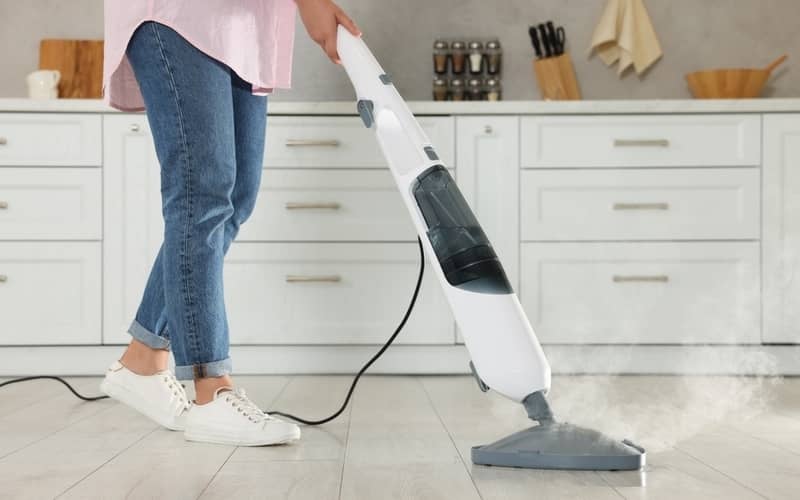
You can steam mop laminate floors only if they’re water-resistant! This type of laminate material has special water-resistant layers that keep out moisture.
As with hardwood, use the lowest setting on your steam mop when cleaning laminate floors.
If your steam cleaner has one, use the soft-bristle attachment so you don’t scuff the floor’s surface.
What Types of Floors Are Not Safe for Steam Mops?
Certain types of floor materials are not suitable for steam cleaning.
Typically, these materials cannot withstand the heat or excess moisture.
- Cork tile: Cork is naturally porous and can swell from wetness or become mouldy
- Natural stone floors: High heat can cause cracks or discolouration in stone such as marble and granite
- Polished concrete: Water can get into porous concrete and erode the material over time
- Traditional laminate: This lacks the water-resistant layer, leading to damage from steam and heat
- Unsealed hardwood: The steam and moisture can cause swelling, mould, or mildew
- Vinyl: Steam can penetrate the vinyl layers to loosen glue, warp panels, and discolour the finish
When cleaning vinyl floors, polished concrete floors, and other unsealed surfaces, it’s better to stick to traditional cleaning methods. You can also look for specialised cleaners for different materials like stone.
Do not use a steam mop to clean hybrid flooring.
How to Use a Steam Mop on Floors
Ready to heat things up? Here’s how to use a steam mop effectively on tiles and other sealed floors.
Pro Tip: Other steam mop uses include benchtops, windows, and even showers!
Pre-clean the floor
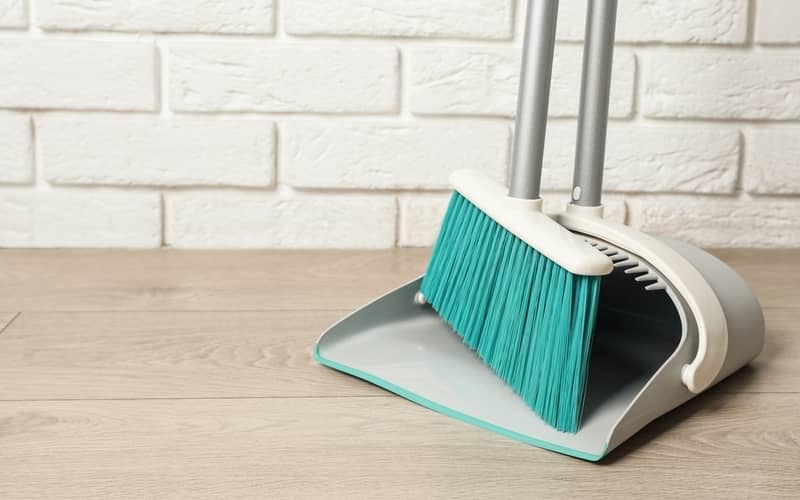
Before you get to steam mopping, you need to prepare the surface – in this case, the floor.
Sweep or vacuum the floor to ensure there’s no loose dirt or debris that can get caught in the mop head. This also prevents the mop from pushing the dirt around and scratching the surface.
Pre-treat old stains or large spills with the appropriate cleaner.
Once you’ve removed surface dirt, assess the floor! If there’s any damage, you may need to use a lower setting or skip the steam cleaner entirely.
Prepare the steam mop
Time to get out the steam mop and cleaning pads!
Check if you need to change out the mop pad before cleaning. Press the release button to remove the old one, and click a new pad into place.
Make sure you use the right mop pad for the floor surface! Soft pads are best for hardwood, while tougher pads are best for tile or linoleum.
Fill the water tank
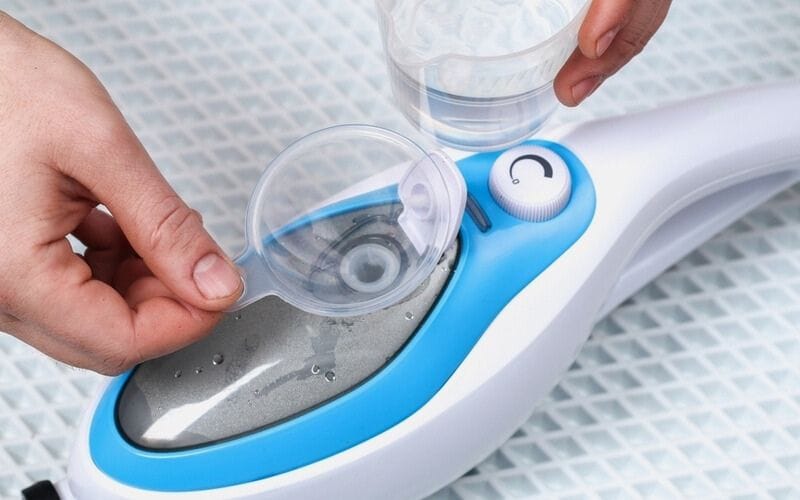
Fill up the reservoir or tank with water – and water only. Refer to the manufacturer’s instructions to avoid any issues.
Make sure you plug the mop in after filling it. Adjust the steam setting based on the flooring material, then wait a minute or two for things to heat up.
Most steam mops have an LED indicator that lets you know when they’re hot and ready!
Steam clean the floor
Start in the furthest corner of the room and mop slowly, using overlapping strokes and light, constant motion. This lets the hot steam penetrate the floor surface, loosening dirt and grime.
From the corner, work your way towards the room’s entrance so you don’t trap yourself in the middle of a newly-cleaned floor!
For stubborn stains, hold the steam mop over the area for a few seconds to let the steam work its magic. Do not leave the mop for too long, though, or it could cause damage.
If your mop is trailing dirt or water, it’s time to change that dirty mop pad! Switch off and unplug your steam mop, then detach the pad.
Securely attach a new pad and continue steam cleaning the floor. You may have to do this several times depending on the level of dirt, so keep multiple mop pads handy.
Once you’re done, allow the floor to air dry completely or go over it with a dry mop. Open the windows or switch on a fan to speed up the drying process.
Do post-cleaning maintenance
After cleaning, switch off the steam mop and unplug it, then let it cool down. Empty the reservoir of any remaining water and dry it thoroughly.
Collect the dirty steam mop pads and wash them. You can do this by hand with hot water, but many brands let you machine wash the pads after use. (Just check the instructions.)
Make sure the mop pads are completely dry before storing them, or they could develop mould and mildew.
How to Use a Steam Mop on Carpet
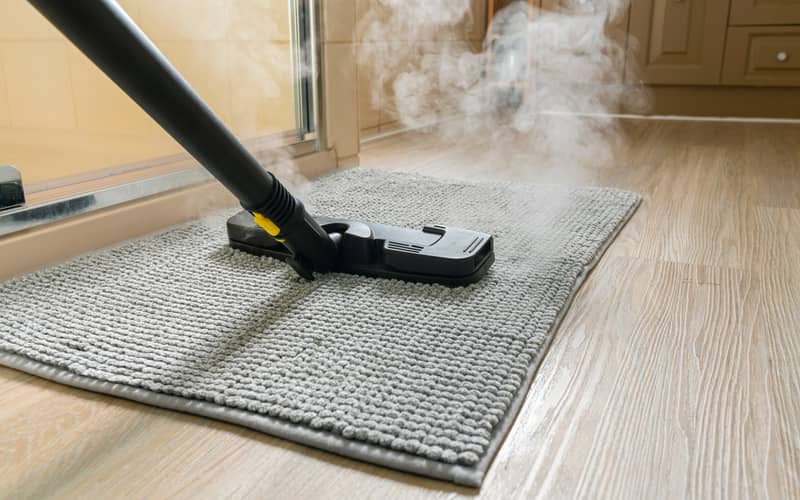
Yes, you can use a steam mop (or steam cleaner) on carpet – if you have the correct attachment and the carpet material allows it.
Steam mops can be a quick and easy way to freshen up carpeted rooms that see lots of traffic.
Check the carpet’s care label or consult the manufacturer beforehand. Follow the instructions for both carpet cleaning and using the steam mop.
Go with distilled water for carpets – tap water can leave mineral deposits on the material.
Vacuum the carpet beforehand to suck up dirt and debris trapped in the fibres.
Move slowly but steadily as you work your way over the carpeted floor. Do several passes over particularly dirty areas if needed.
Switch off and unplug the steam mop, then let it cool before emptying the tank.
Let the carpet completely dry – it usually takes around 8-12 hours, but could need an entire day. You can switch on a fan or open the windows to speed things up.
Tips for Using and Maintaining a Steam Mop
When it comes to steam mops, here are some useful tips for making the most out of your tool – and maintaining it, too!
Use it on the appropriate flooring materials
Only use the steam mop on the correct floor types – typically, sealed floors.
You can test the mop on a small spot before cleaning to make sure it doesn’t damage the material. But if you’re not sure, it’s best to stick to traditional mopping.
Change and wash mop pads
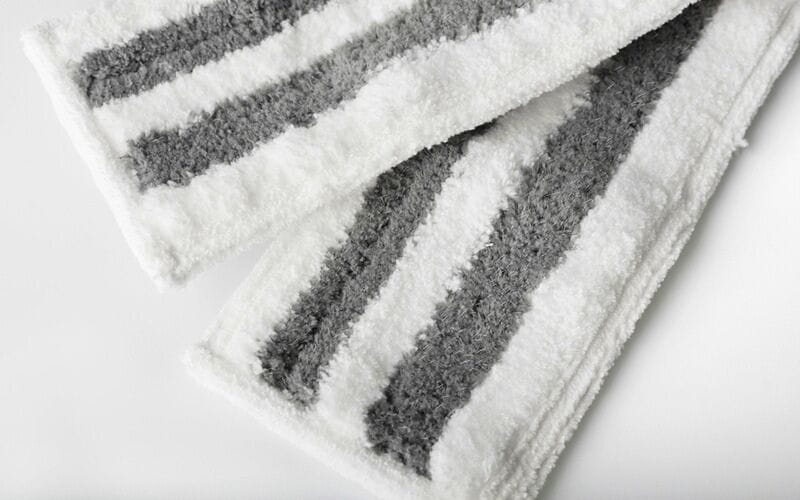
Change the mop pad regularly while mopping, and make sure you clean the steam mop pads after every use.
Washing helps remove the dirt and grime that the cleaning pad absorbs during use. That minimises the risk of mould or mildew, and prevents the pads from becoming smelly.
For mop pads that are too dirty, ratty, or torn, it’s best to replace them with new ones.
Keep the steam mop in good condition
You’ll need to clean and maintain your steam mop properly! That keeps it in good working condition and can even prolong its lifespan.
Do not use a steam mop on a heavily soiled floor or large mess. It’s best for routine cleaning – if there’s too much dirt, you’ll end up smearing it all over the floor or overloading your machine.
Check the water reservoir after use to ensure there’s no limescale or dirt build-up. You can wash it with hot water and soap, then dry the tank before putting it back.
Regularly inspect the mop head to make sure there’s no trapped debris that could cause damage.
And of course, always make sure your steam mops are fully cooled and dry before storing them!
Steam Mop vs. Regular Mop: What’s Better?
Everyone has their preferences, but steam mops are generally more convenient and efficient than traditional mops.
| STEAM MOP | TRADITIONAL MOP | |
| PROS |
|
|
| CONS |
|
|
With a traditional mop, you’ll need a separate cleaning product, which may not be safe for pets or people with allergies. Moreover, you use more water and more effort when mopping.
However, traditional mopping is best for delicate surfaces like vinyl floors or natural stone, which are sensitive to heat. Regular mops are also more affordable and better for deep cleaning.
On the other hand, steam mops require less effort and use less water when cleaning. There’s no need for additional products since the heat and steam can tackle dirt by themselves.
Steam mops can’t clean all flooring types, though. The mop itself has a higher upfront cost, and you’ll also need to purchase more mop pads (which leads to more waste).
You also can’t use a steam mop for large spills as they’re not designed for heavy absorption.
Not sure which mop to use? Just leave the mopping – and the rest of the chores – to a professional home cleaning service.
Hot Topics: FAQs About Steam Mops
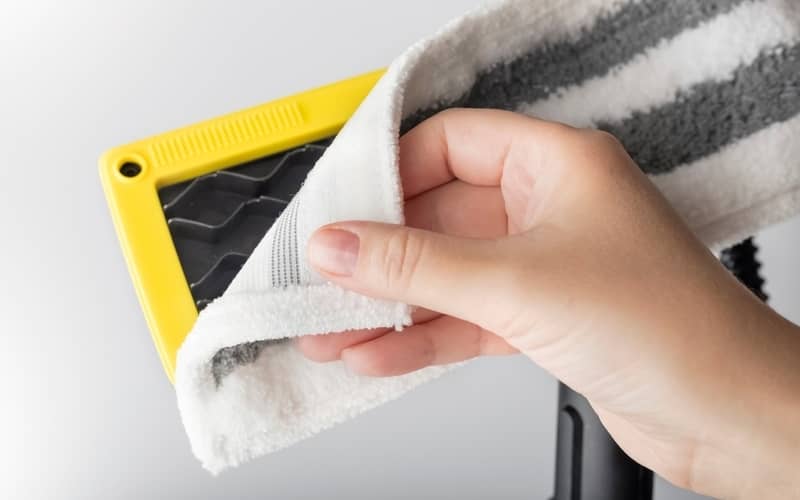
Do you have other questions about how to use a steam mop? Let’s mop them up!
Do you use a steam mop before or after mopping?
Neither – you should use a steam mop by itself.
You should only be using a steam mop after mopping when dealing with a large spill or mess.
In this situation, a traditional mop is better for cleaning – but you can steam mop afterwards to remove any deep-seated dirt.
Do you just put water in a steam mop?
Yes, you should only use water in a steam mop – that’s how it works!
However, if you live in a hard water area, consider using distilled water instead of tap water.
This minimises limescale or mineral build-up, which could damage the mop or cause bacterial growth.
What can I put in my steam mop water tank?
You should only put water in the water tank, as that’s all you need to wash floors.
Certain brands like Bissell have demineralised water specially formulated for steam mops. It adds a pleasant scent and gives the mop a cleaning boost.
Some manufacturers allow you to use diluted vinegar – mixing equal parts vinegar and water in the reservoir. Always consult the manual before to ensure you don’t damage your mop.
What to spray on the floor before steam mopping?
Generally, there’s no need to apply anything to the floor before steam mopping.
If you’d like, you can spray some white vinegar for some extra cleaning power!
Another option is to use a homemade essential oil spray or scent disc to make the steam mop smell nice.
Can you put a floor cleaner in a steam mop?
No, you should never put floor cleaner in a steam mop!
These appliances are designed for water only. Adding commercial cleaners can clog or even damage the machine and leave residue on your floors.
If you want to use a floor cleaner for a deeper clean, apply it to the floor before steam mopping.

